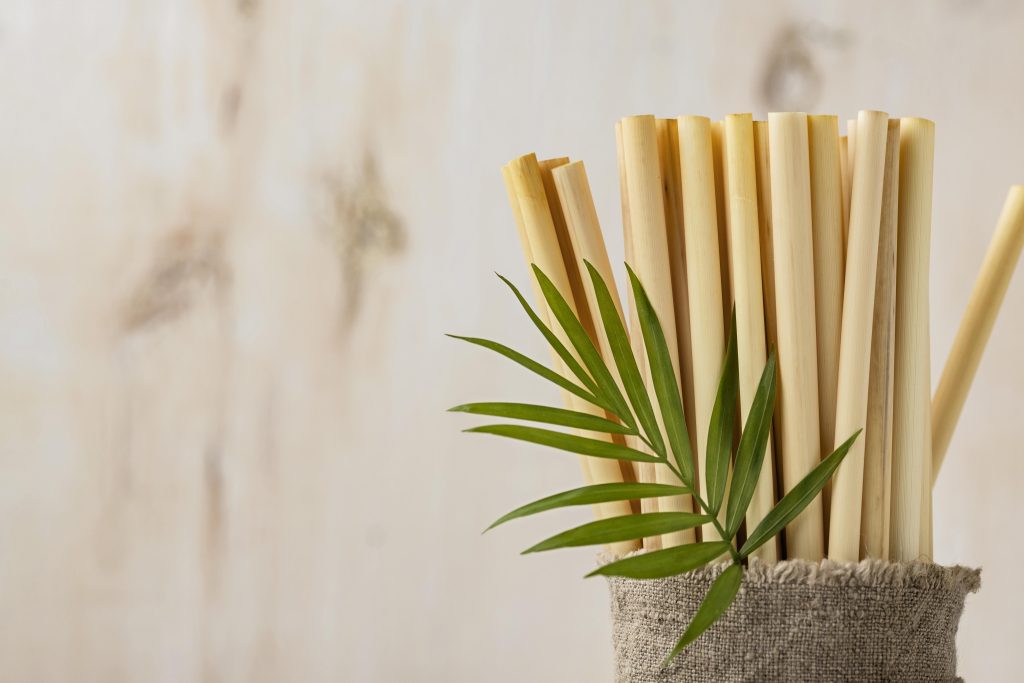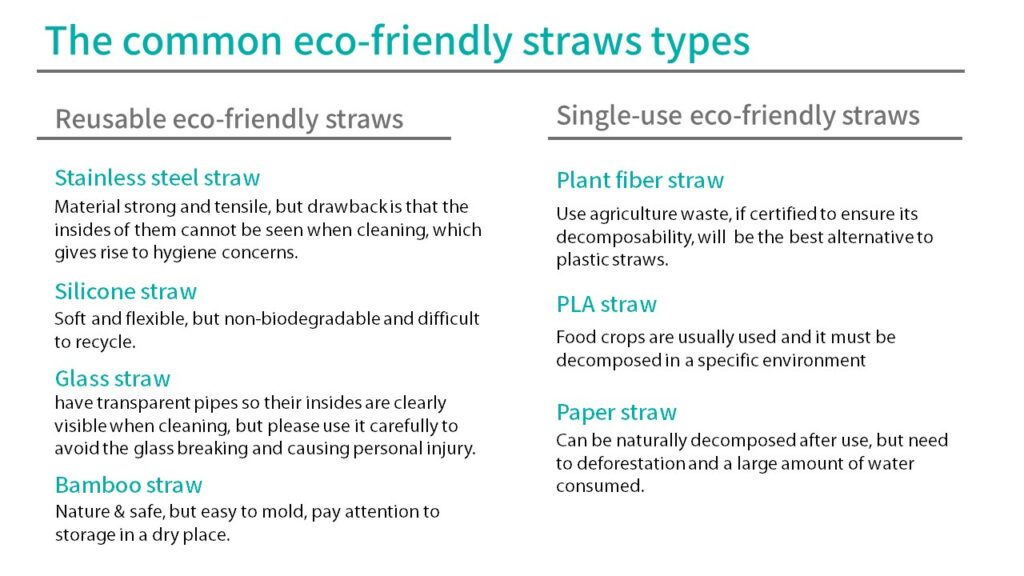
Eco-friendly straws have been trending around the world in the past 5 years. In 2018, a photo of a straw sticking in the nose of a turtle shocked the world. Many people has since realized that the little plastic tubes used for enjoying drinks can, without being noticed, severely damage the environment. Hence, countries have started to establish laws and regulations to restrict the use of single-use plastic straws. For example:
- the EU announced the “Directive on single-use plastics” in June 2019. It took effect in 2021, and straws have been included in the list of banned items.
- Led by Seattle, 15 cities in the US have banned single-use plastic straws.
- Taiwan has prohibited using single-use plastic straws at food places since 2019.
- The “Law of the People’s Republic of China on the Prevention and Control of Environmental Pollution by Solid Waste” specifies that the production, sales, and use of non-degradable single-use plastic straws have been prohibited and restricted starting from 2021.
As a result of this trend, eco-friendly materials as substitutes for plastic straws have sprung up like mushrooms. For example, the single-use paper and plant fibers (e.g. wheat and bagasse) as well as reusable silicone, stainless steel, glass and bamboo are all common eco-friendly materials used to make straws. We will introduce different types of eco-friendly straws as well as suggesting the best choice of them in 2023 below.
What is Eco-Friendly Straw?

As a substitute for plastic straws, eco-friendly straws can better protect the environment in many respects. The source material of plastic is non-renewable whereas eco-friendly straws consist of various renewable materials based on plant fibers. Paper straws, most common, are made of trees.
Most people choose to use a plastic straw one time because of hygiene and texture issues. By contrast, straws made of materials such as stainless steel, glass and bamboo are strong and thick enough to be reused after cleaning. This helps reduce the amount of waste.
It also takes a very long time for plastic to be naturally decomposed in the environment. It can last for hundreds of years and generate microplastics during the decomposition process. These particles reach every corner of the world through the water cycle, absorb hazardous substances (e.g. heavy metals), then invade the body of organisms and further damage their health. However, straws consisting of plant fibers such as bagasse are specially designed to be degraded into nutrients in normal environments, which is favorable to the environment.
2 Types of Eco-Friendly Straws
Eco-friendly straws can be roughly divided into two categories: reusable and single-use. They will be introduced below along with the common types in the market one by one.

Reusable eco-friendly straws
Reusable eco-friendly straws include:
- Stainless steel straw – Eco-friendly straws made of stainless steel usually have the color of stainless steel. The advantage of a strong and tensile material enables them to be reused for several years. The drawback is that the insides of them cannot be seen when cleaning, which gives rise to hygiene concerns. Moreover, when drinking chilled drinks with stainless steel straws, they will be as cold as the drink and can possibly cause a metallic taste, further affecting the experience of using them.
- Silicone straw – For silicone straws, the experience of using them is the closest to plastic among all reusable straws as they are soft and flexible. Nonetheless, silicones are non-biodegradable and difficult to recycle, like plastic. Furthermore, there might be a risk of additional chemical agents including BPA in silicone straws.
- Glass straw – Glass straws have transparent pipes so their insides are clearly visible when cleaning, and this allows them to have better hygiene than other reusable eco-friendly straws. Yet, if collision occurs due to any accidental slip when bringing or using glass straws, they can easily generate glass shards because of their brittleness. These shards might cut the mouth or even be swallowed with drinks.
- Bamboo straw – Bamboo straws are made of cut bamboo with smaller caliber, such as arrow bamboo. After disinfecting and polishing, these bamboo can be reused and even decomposed in natural environments. However, considering that molds easily grow on plant fibers and users cannot be sure about the cleanliness in the non-transparent straw pipes, bamboo straws give rise to hygiene concerns.
Single-use and decomposable eco-friendly straws
Single-use and decomposable eco-friendly straws include:
- Plant fiber straw: The straws manufactured from plant fibers including wheat stalks and bagasse have a natural color and pellets of fibers on the appearance. Bagasse straws use agricultural by-products as materials, so they can help reduce waste from sugar production. Moreover, bagasse straws do not become soft when soaked in water, do not require planting o additional crops, and can be biodegraded as well as composted. Some products such as renouvo’s bagasse straws are even certified as home compostable, meaning that these straws can be decomposed in the yard at home. Currently, these straws are the best substitute for single-use plastic straws.
- PLA straw – PLA is the abbreviation of “Polylactide.” Straws made of PLA are refined from plant fibers through fermenting, dehydration and purification with an appearance extremely similar to plastic straws. They can be made transparent or colored, thus providing an experience similar to using plastic straws. They also have disadvantages. The raw materials of PLA eco-friendly straws are usually cash crops like corn and wheat, which might create grain risks. Additionally, these straws can only be decomposed in an environment of high-temperature composting under 58°C to 60°C. If they are directly buried into the soil, they would still last for quite a long time.
- Paper straw – Paper straws have the longest history in the commercial market. People had been widely using them way before plastic straws, and they can be naturally decomposed after use. It is a shame that the raw material of paper straws comes from wood, so their production requires harvesting trees, i.e. deforestation. This can further worsen global warming. Also, a large amount of water and chemical agents would be consumed and used in the production process, further causing pollution in surroundings. What’s more, after being soaked in drinks, paper straws might become soft and provide additional paper-like taste, affecting the drinking experience.
Why Eco-Friendly Straws? 7 Benefits of Using Eco-Friendly Straws
Protection of marine ecosystems
After plastic straws enter the environment, they are easily washed away by rain and carried into rivers, and finally end up accumulating on the ocean surface. As a result, marine life might ingest plastic straws by accident. Not only that, but these straws can also cover the ocean surface and cause the death of seaweed, which will further destroy the whole marine ecosystem.
Protection of health
Hazardous chemical substances might be released when plastic straws are soaked in liquid, especially in hot, acidic, or alkaline drinks. In contrast, most eco-friendly straws consist of natural plants or stable substances, making them risk-free and safe to use.
Waste volume reduction
The waste piling up as mountains around the globe has created a huge impact on people’ living environments. By using eco-friendly straws, not only the amount of waste that is hard to decompose can be reduced, but people can also enjoy wider living environments. Moreover, the air pollution caused by waste incineration will also decrease.
Mitigation of global warming
Plastics are petrochemical products. Not only is their material non-renewable, a large volume of greenhouse gases can also be generated in the process of exploitation and refining. Hence, global warming would be aggravated.
Deepening of environmental awareness
Straws are common necessities in the daily life of people. By continuously practicing responsible consumption in everyday life, people’s awareness of environmental sustainability can be deepened and further reflected in more aspects.
Reduction of microplastics
Microplastics can be generated from plastic straws in landfills or natural environments. They will reach every corner in the world through the water cycle and hazardous substances eventually enter the human body when people enjoy seafood or drink water, threatening their health.
Safety and convenience
Many people would say “not using is the best way to protect the environment” when discussing issues of eco-friendly straws. Indeed, drinking directly from a bottle or a cup is the best choice to protect the environment as it avoids producing additional products. Nonetheless, straws provide children and the elderly a safer way to drink. In addition, they effectively prevent drinks from being spilled and offer convenience to athletes, drivers and others who have their hands full. Even more, straws are a more sanitary choice as they prevent saliva from getting into the drinks. Therefore, the use of straws is still necessary in many circumstances.
FAQ About Eco-Friendly Straws

What are eco-friendly straws made of?
Most eco-friendly straws consist of metal, plant fibers, glass and silicone. As every material has a distinctive nature, the straws are suitable for users with different needs.
Can eco-friendly straws be recycled?
Some eco-friendly straws made of specific materials are designed to be recyclable. For example, straws made of glass and stainless steel can be completely recycled and re-manufactured into new products. Yet, it means that they are difficult to decompose in normal environments. Hence, these eco-friendly straws must be properly recovered in order to truly benefit the environment.
Can biodegradable eco-friendly straws be buried in the backyard?
Most eco-friendly straws including bamboo, bagasse, PLA and paper straws are biodegradable. However, note that the straws which fibers have been modified in nature (e.g. PLA straws) are difficult to decompose in the backyard at home as they require a temperature above room temperatures. Furthermore, pay attention to whether paper straws contain additional chemical substances such as lamination or dyes. If that is the case, directly burying the straws in the yard at home will damage the environment as well. Thus, please select eco-friendly straws certified as “home compostable” as the composting materials in the backyard.
How to clean eco-friendly straws? Can they go in the dishwasher?
In most cases, long-handled cleaning brush is needed to clean the inside of a reused eco-friendly straw. If some eco-friendly straws are certified as dishwasher safe, they can also be cleaned in the dishwasher.
Where can eco-friendly straws be bought?
For general consumers, eco-friendly straws can simply be purchased from online shops or in physical stores. If the seller would like to practice responsible production and provide the customer with a satisfying user experience, he or she may choose to offer decomposable single-use eco-friendly straws. For example, Renouvo has been providing low-carbon and home compostable sugarcane straws along with worldwide shipping.
Under what circumstances are eco-friendly straws suitable for use in daily life?
Eco-friendly straws are suitable for use when running, biking, driving, enjoying afternoon tea or any time you would like to have a drink. However, please remember to avoid using eco-friendly straws made of hard materials such as glass or stainless steel during exercise to prevent injury.
Summary
Plastic straws have brought convenience to people for decades. We have now become aware that they have also severely impacted the environment. Though countries around the world have started banning single-use plastic products for factors including global warming and marine pollution, we still hope to maintain the usual convenience through eco-friendly straws while reducing the environmental burden. With this, we may even recover and reuse waste to benefit the environment and have more fun in life, achieving a win-win situation.